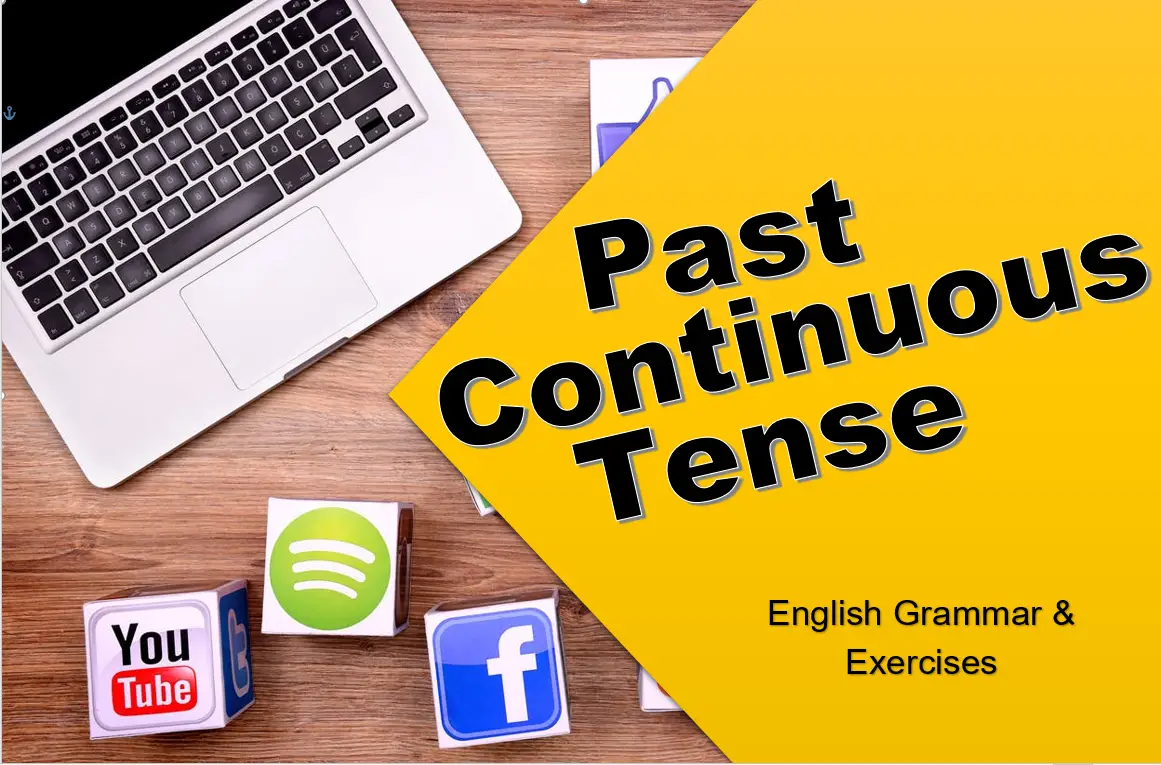PAST CONTINUOUS TENSE MEANING | Grammar and Exercises
The past continuous tense is used to express acts that started in the past and persisted for a short time after they began. This lesson explains the meaning of PAST CONTINUOUS TENSE and provides examples on its form/formation.
In this complete tutorial for beginners, learners are going to learn that Past continuous tense is used to tell actions that started in the past and often continued for a short period of time after the action started. This tense describes actions or events that happened at a specific time in the past.
The past continuous is formed from the past tense of “to be” with the base of the main verb plus the ending “-ing” form of the verb.
Watch the video of Full discussion of Past Continuous Tense Meaning and Formation Example here.
Past Continuous Tense Form/Formation:
- Affirmative form: Subject + past form of verb “to be” + -ing form of verb
(auxiliary verb) (main verb)
| Subject | Auxiliary Verb (past form “to be”) | Main Verb (ing-form) |
| I | was | going |
| You | were | going |
| He/She/It | was | going |
| We | were | going |
| They | were | going |
- Negative Form: Subject +past form of verb “to be” + not +-ing form of verb
| Subject | Auxiliary Verb (past form “to be”) | Not | Main Verb (ing-form) |
| I | was | not | going |
| You | were | not | going |
| He/She/It | was | not | going |
| We | were | not | going |
| They | were | not | going |
- Contracted Form Negative
| I was not going | ð | I wasn’t going |
| You were not going | ð | You weren’t going |
| He was not going | ð | He wasn’t going |
| She was not going | ð | She wasn’t going |
| It was not going | ð | It wasn’t going |
| We were not going | ð | We weren’t going |
| They were not going | ð | They weren’t going |
- Question Form: past continuous tense formation of verb “to be” + subject + – ing form of verb ?
| past form of verb “to be” | Subject | -ing Form of Verb |
| Was | I | going? |
| Were | you | going? |
| Was | he/she/it | going? |
| Were | we | going? |
| Were | they | going? |
Question form with question words
- Why was he crying? – In this example question word is “why” and then we have the normal question form “was he crying?” with the question mark.
- Where were they playing? – Question word is “where” and the question form.
- What was he cooking? – Question word is “what” and the question form.
The form here is we have the question words either “what”, “where”, “why”, “who”, “how” and then we have the past form of “to be” + subject + -ing form of verb followed by the question mark at the end.
-ing form
What is the -ing form?
The basic rule for regular verbs is that for regular verbs we simply add letters –ing to the base form. For example, the base form is “go” and so the “-ing” form is “going”. This is the only rule for regular verbs, there are a lot of other rules and exceptions for irregular verbs, and for all the rules for the -ing form go to englishtutorhub.com for a complete transcript of the –ing form and examples.
Past continuous Tense – uses and Formation
a. To describe a long action in the past that started before a specific time.
The long action is continuing after the specific time.
Example of Past Continuous Tense with a specific time:
1. Last night at 7pm, I was watching football.
So “Last night at 7pm” is the specific time and then we have the long action “I was watching”.
2. At 5pm she was cooking.
So the same situation 5 pm is the specific time and at that time she was cooking. She is in the middle of cooking or in the process of cooking. Past continuous, she started for example at 4:30 and finish at 5:30 so at 5 o’clock she was cooking.
Interrupted long action in the past
We use past continuous to describe a long action in the past that is interrupted by a short action. We use the past simple for the short action that interrupts it.
Example of Past Continuous Tense with past simple:
“I was going to school when you called me” or we can also change the order: “When you called me, I was going to school”.
These two sentences are both correct and they both mean exactly the same thing. You notice when we say “When” we use the past simple. So when we introduced the clause “you called” using the past simple then we use “when + past simple”.
Another example:
1. “I was living in Phuket when I met Roger”.
Or we change the order:
2. “When I met Roger, I was living in Phuket”.
Or we also have other way of saying this;
3. “While I was living in Phuket, I met Roger”.
Or we change the order:
4. I met Roger while I was living in Phuket.
So, these 4 sentences they are all correct, they mean the same thing, the difference is with past continuous we use the word “while” so we have “while + past continuous” or “when + past simple” and we do this to join both actions to join the long actions with the short action to connect them.
Set the scene in a story
We use the past continuous to set (describe) the scene in a story before the real action starts. We use the past simple for the real action.
Example of Past Continuous tense:
“Tom and Jerry were walking in the park. The children were playing volleyball and dogs were running.”- so this is just the scene of the story, it is the background, it is a general description of the scene of the story and then the real action starts. “Suddenly a man ran towards the children”. – So this is the main action of the story and that’s why we use the past simple. So the past continuous is the background to the scene and then the real action (ran) is the past simple.
“Always” to describe annoying habits in the past
We use the past continuous with “always” to describe annoying habits in the past.
Examples of describing describe annoying habits in the past continuous tense:
- Our neighbor was always fighting.
- Roger was always complaining.
Several actions at the same time
We use the past continuous to describe actions that happened at the same time.
Example:
- While Peter was ironing clothes, Ryan was cooking dinner.
- Matt was writing some articles while I was mopping the floor.
Non continuous verbs
Some verbs do not have a continuous form. Most of them are called stative verbs.
List of common verbs that do not have a continuous form.
believe love see
doubt hate suppose
feel prefer think (= believe meaning)
imagine realize understand
know recognize want
like remember wish
and others…
Example: The vanilla cake was nice. I was wanting another slice. X
The vanilla cake was nice. I wanted another slice. ü
Past Continuous Tense Exercises
Past Continuous Tense Exercise 1: Put the verbs into the correct form past continuous.
1. When I phoned my friends, they (play) ____________ monopoly.
2. Yesterday at six I (prepare) ____________ dinner.
3. The kids (play)____________ in the garden when it suddenly began to rain.
4. I (practice)____________ the guitar when he came home.
5. We (not / cycle) ____________ all day.
6. While Aaron (work)___________ in his room, his friends (swim)___________ in the pool.
7. I tried to tell them the truth but they (listen / not) ____________.
8. What (you / do) ___________ yesterday?
9. Most of the time we (sit) ____________ in the park.
Past Continuous Tense Exercise 2: Make the correct form of the past continuous.
1) (he / cook)
2) (she / play cards)?
3) (you / sleep when I got home)?
4) (it / rain at lunchtime)
5) (what / you / do)?
6) (why / she / run)?
7) (how / we / do at that time)
8) (you / shop when I called you)
9) (she / eat dinner when we arrived)
10) (he / live in Tokyo at the time)?
Answers for Exercise 1
1.When I phoned my friends, they were playing monopoly.
2. Yesterday at six I was preparing dinner.
3. The kids were playing in the garden when it suddenly began to rain.
4. I was practicing the guitar when he came home.
5. We weren’t cycling all day.
6. While Aaron was working in his room, his friends were swimming in the pool.
7. I tried to tell them the truth but they weren’t listening.
8. What were you doing yesterday?
Answers for Exercise 2
1. He was cooking
2. Was she playing cards?
3. Were you sleeping when I got home?
4. It was raining at lunchtime
5. What were you doing?
6. Why was she running?
7. How were we doing at that time?
8. You were shopping when I called you.
9. She was eating dinner when we arrived
10. Was he living in Tokyo at the time?
Downloadable Material
Here’s the downloadable material of Full Tutorial on formation of Past Continuous tense in English grammar with example and exercises.
For more readings
- Quiet or quite / Confusing English words
- Expressing PREFERENCES: English Lesson
- Comparing Things with “AS” / English Grammar
- Comparative Adjectives – English Grammar Lesson
- Adjectives in English Grammar – Position in a Sentence
If you have any questions or suggestions about form and example Past Continuous tense in English grammar, please feel free to leave a comment below or send us a message using our contact page.


